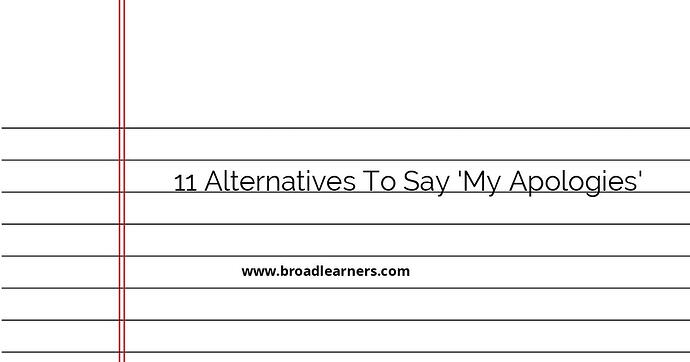When you need to apologize for a mistake or misunderstanding, it's important to do so in a professional and sincere manner. Saying 'My apologies' is a common way to express regret, but there are several alternatives that can help you convey your remorse effectively. In this article, we have compiled 11 professional ways to apologize for a mistake or misunderstanding:
- I apologize for the inconvenience.
- I'm sorry for any confusion caused.
- Please accept my sincere apologies.
- I regret any inconvenience this may have caused.
- I apologize for my oversight.
- I take full responsibility for the error.
- I acknowledge my mistake and apologize.
- I deeply regret the misunderstanding.
- I'm truly sorry for the oversight.
- My sincere apologies for the confusion.
- I apologize for any inconvenience this has caused.
Let's explore each alternative in more detail:
1. I apologize for the inconvenience
This phrase acknowledges that a mistake or misunderstanding has led to inconvenience for the other party. It shows your recognition of the impact of your actions and your willingness to express regret.
Example:
Dear [Recipient's Name],
I apologize for the inconvenience caused by the error in the report. I take full responsibility for the oversight and am working to rectify it promptly.
Best regards,
[Your Name]
2. I'm sorry for any confusion caused
By apologizing for any confusion caused, you express regret for the lack of clarity or misunderstanding that may have arisen. This statement aims to address the impact of the situation on the recipient.
Example:
Hi [Recipient's Name],
I'm sorry for any confusion caused by the miscommunication. Please let me know how I can clarify things and make it right.
Warm regards,
[Your Name]
3. Please accept my sincere apologies
This formal apology conveys your sincerity and earnestness in seeking forgiveness for the mistake or misunderstanding. It demonstrates your willingness to make amends and improve the situation.
Example:
Dear [Recipient's Name],
Please accept my sincere apologies for the oversight in scheduling the meeting. I value our professional relationship and will ensure such errors are avoided in the future.
Warm regards,
[Your Name]
4. I regret any inconvenience this may have caused
By expressing regret for any inconvenience caused, you show empathy towards the recipient and acknowledge the potential impact of the mistake or misunderstanding on their end. It reflects your concern for their experience.
Example:
Hi [Recipient's Name],
I regret any inconvenience that may have been caused by the delay in response. Your time is valuable, and I apologize for any disruption this may have caused.
Sincerely,
[Your Name]
5. I apologize for my oversight
By apologizing for your oversight, you take ownership of the mistake or misunderstanding without making excuses. This phrase indicates that you recognize the error and are committed to addressing it.
Example:
Dear [Recipient's Name],
I apologize for my oversight in missing the deadline for submission. I am taking immediate steps to rectify the situation and prevent such occurrences in the future.
Regards,
[Your Name]
6. I take full responsibility for the error
By stating that you take full responsibility for the error, you demonstrate accountability and a willingness to own up to your mistakes. This shows maturity and a commitment to resolving the issue.
Example:
Hi [Recipient's Name],
I take full responsibility for the error in the calculations that led to the discrepancy. I am working diligently to correct it and will keep you updated on the progress.
Best regards,
[Your Name]
7. I acknowledge my mistake and apologize
This straightforward apology involves acknowledging your mistake and offering a direct apology. It shows humility and a willingness to admit fault, which can help rebuild trust and rapport.
Example:
Dear [Recipient's Name],
I acknowledge my mistake in providing the incorrect information during our last discussion. I sincerely apologize for any confusion it may have caused.
Warm regards,
[Your Name]
8. I deeply regret the misunderstanding
Expressing deep regret for the misunderstanding conveys the significance of the impact on the recipient. It shows a profound sense of remorse and a commitment to clear up any confusion or misinterpretation.
Example:
Hi [Recipient's Name],
I deeply regret the misunderstanding that occurred during our negotiation. It was not intentional, and I am committed to clarifying the situation for mutual understanding.
Sincerely,
[Your Name]
9. I'm truly sorry for the oversight
By stating that you are truly sorry for the oversight, you emphasize the sincerity of your apology and your genuine regret for the mistake. This phrase conveys your commitment to preventing similar errors in the future.
Example:
Dear [Recipient's Name],
I'm truly sorry for the oversight that led to the confusion in our correspondence. Rest assured, I am taking corrective measures to ensure such oversights do not recur.
Warm regards,
[Your Name]
10. My sincere apologies for the confusion
By offering your sincere apologies for the confusion, you demonstrate genuine remorse and a desire to rectify the situation. This phrase aims to show empathy and understanding towards the recipient's perspective.
Example:
Hi [Recipient's Name],
My sincere apologies for the confusion caused by the miscommunication. I value our partnership and am committed to ensuring better clarity in our future interactions.
Best regards,
[Your Name]
11. I apologize for any inconvenience this has caused
This apology acknowledges any inconvenience caused by the mistake or misunderstanding, emphasizing your concern for the recipient's well-being. It shows your willingness to address the repercussions of the error.
Example:
Dear [Recipient's Name],
I apologize for any inconvenience this oversight has caused you. Your satisfaction is important to me, and I am committed to resolving this matter satisfactorily.
Sincerely,
[Your Name]
These professional alternatives to 'My apologies' can help you navigate apologies for mistakes or misunderstandings with grace and sincerity. By choosing the right expression of regret, you can demonstrate professionalism and a genuine desire to rectify the situation.
Did I miss anything? Respond below
